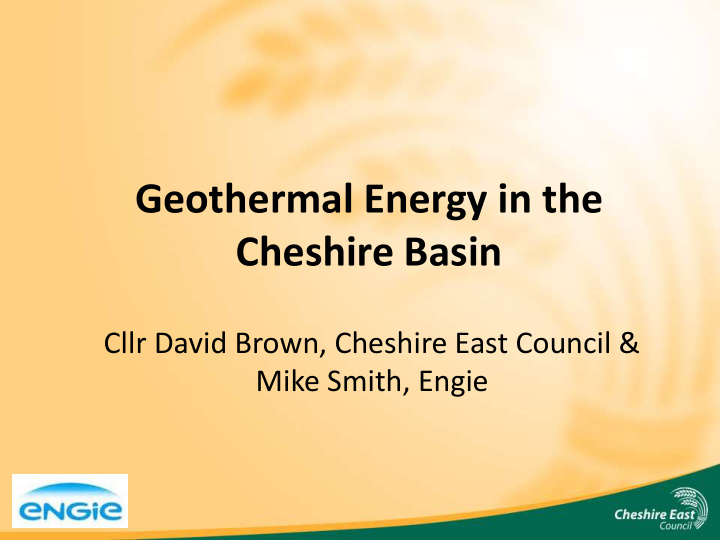



Geothermal Energy in the Cheshire Basin Cllr David Brown, Cheshire East Council & Mike Smith, Engie
Why the Cheshire Basin? • Low heat flow, but high hydro-physical parameters. • Favourable geological conditions and under highly populated areas. • The basin contains a huge Crewe resource – the same amount of energy produced from 3 billion barrels of oil (Hirst et al., 2015).
Why the Cheshire Basin?
Why Geothermal? • Clean - almost carbon free. • Secure - renewable energy recharge from the Earth’s natural thermal gradient. • Affordable - only costs 1p/kwh to produce. • Nationally important - 60% of the UK heat demand. 70,000+ jobs in exploration and construction, £4.5bn GVA. • Local Growth - power 6,740 homes and reducing 7-8,000 tonnes of CO2. 200 FTE’s and £10m GVA. • Supports Crewe High Growth City/HS2
Our Journey to Date • As part of the ‘Ambition for all sustainable communities Strategy (2010-2025), the Council has put forward a vision of a step change towards renewable sources. • Complements the Carbon Reduction Programme – 42% reduction since 2008 from streetlighting and buildings. • 2014 –Council’s Cabinet made the decision to pursue deep geothermal energy. Secured feasibility funding • 2015 – Council’s Energy Framework identified Geothermal energy as key opportunity. Knowledge Transfer Partnership with Keele University. • 2016 – Joint Venture with Engie for geothermal and heat networks, and funding bids for exploration.
Geothermal Funding • Aim to de-risk the basin through a 4- 5km deep exploratory well in Crewe. • Two applications being progressed from European and Local Growth funding.
Heat Networks Macclesfield Crewe Town Centre Hurdsfield Heat network development stage diagram.
Cheshire Energy Networks Ltd • Joint venture (JV) with Engie has been established. • The partnership aims to install the infrastructure for geothermal and heat networks. – Initial focus on Cheshire East. – The JVA is not geographically restricted - can operate anywhere across the UK. http://www.cheshireeast.gov.uk/council_ – Compliant procurement for use by and_democracy/council_information/med other local authorities – can help you to ia_hub/media_releases/council- announces-new-clean-energy- deliver your targets. development-partnership.aspx
ENGIE – Leading the Energy Transition in Europe
ENGIE Profile of UK Business Unit
Engie’s commitment to the use of deep geothermal energy Engie is: • maintaining long term investment in its existing deep geothermal resource • exploring opportunities for new resources • providing clients with an easier route to exploit geothermal resources
Southampton Aquifer: an existing resource in the heart of the city Largest commercially developed integrated Geothermal/CHP district energy scheme in the UK Started 9 years ago Built on Joint Co- Operation Agreement with Southampton City Council Energy Centre
Engie maintaining investment in deep geothermal energy New downhole pump fitted in Southampton in 2016
Engie maintaining investment in deep geothermal energy New downhole pump in Southampton
Cheshire East Networks A new opportunity for Engie to work with a dynamic local authority in an energy joint venture to: develop heat networks,and incorporate deep geothermal energy
A Turnkey Service • An easier route for clients to exploit geothermal energy - a turnkey service offered by Urban Energy, Storengy and Cheshire East Council (CEC) • Through its subsidiary companies Urban Energy and Storengy, and its JV with CEC, Engie has the skills, experience and capacity to provide a turnkey service to develop district heating networks using deep geothermal resources. • With Storengy and CEC it is able to undertake both the subsoil works, the development and operation of the surface District Energy Network (s) and the critical public sector processes and knowledge.
ENGIE’s UK District Energy schemes Cheshire Midlands Cheshire Energy Networks Leicester District Energy Birmingham District Energy Coventry District Energy London Berryfields Estate Olympic Park & Stratford City EXcel Whitehall South Coast Bloomsbury Heat & Power Greenwich Millennium Village Southampton Geothermal Equinox, Hatfield Eastleigh
Integrating Energy Technologies Sources of low carbon heat used by Engie in its district energy schemes:- CHP Energy from Waste Biomass Solar Geothermal Others likely to be added in next few years
Characteristics of Success of a District Heating Scheme The DE Triangle Diversity Density Deliverability
Density • What does it mean? – Heat density (kWh/m 2 ) – Proximity of buildings • Why is it important? – Reduces capital cost due to reduced network costs – Reduces highway buried services risk – Increases financial viability
Diversity • What does it mean? – Mix of building types – Usage at different times of day/year – Usage for different loads - DHW; space heating; process heating – Existing buildings – a function of the existing urban geography – New Developments – mixed use is quite common for larger developments • Why is it important? – Geothermal, CHP and other low carbon plant operates optimally at continuous output – Diverse loads provides year round base load – Increases CO 2 savings and financial viability – Can reduce peak demand significantly
Deliverability • Several key issues including; – Potential for long term contract – Number of customers – Nature of customers – Risks and de risking – Revenue certainty and financing – Timing (phasing of loads) • Key questions; – Who will the contracting party be? – How much of the project can they commit to? – Does this provide sufficient certainty around energy consumption, energy sales and appropriate plant selection?
Conclusions • Geological modelling will continue to determine how best to develop geothermal energy in the Cheshire East & Crewe area. • We are working hard to de-risk the exploitation of the potential geothermal resource . • Innovative partnerships have been formed to capitalise on this resource and start development of the heating networks – available to assist other areas. • We are leading, at risk, and the UK still needs to support the industry further to deliver the benefits.
Recommend
More recommend